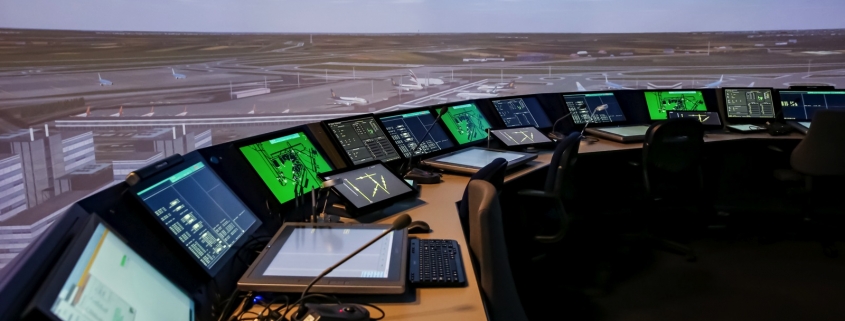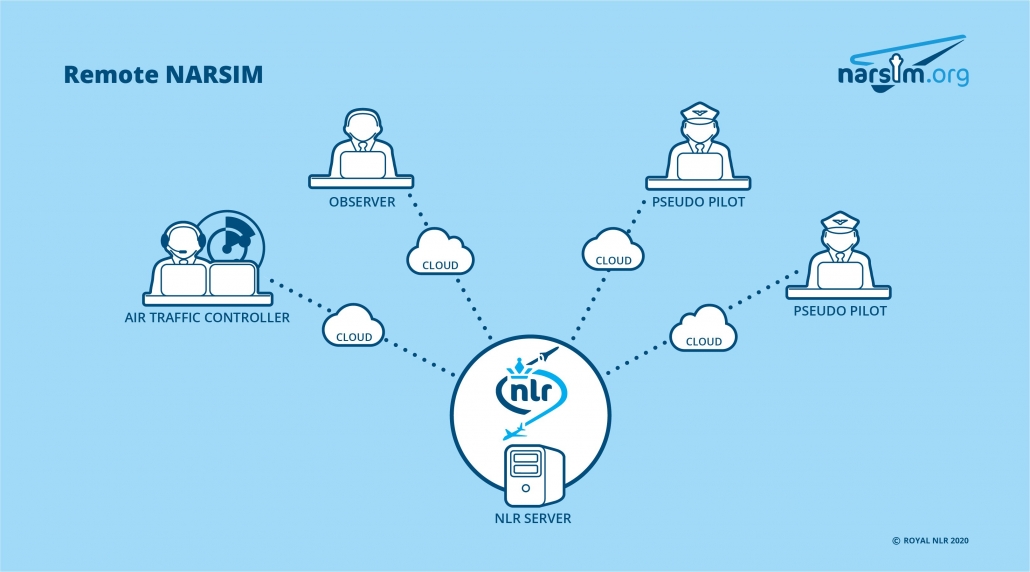Due to COVID-19, virtually everyone in the world is having to adapt and overcome a strange set of circumstances to keep life as close to “normal” as possible. Royal NLR is certainly no exception to that rule. But with some creativity and a fair amount of ingenuity, the NARSIM team is finding new and safer methods to execute ATC research and testing simulations despite the unusual times.
Success in innovation doesn’t only come from inventing or developing new technologies and products. Sometimes it can be as simple as finding new ways to utilize existing technologies in a way that works for your specific needs. One such example comes from the team at NLR’s Air Traffic Control Research Simulator (NARSIM). NARSIM has developed a new method to offer various Corona-proof, remote training sessions, such as its air traffic control (ATC) training course, by using everyday technologies that have become ubiquitous during the pandemic – virtual networks and Microsoft Teams.
Pseudo pilots
Typically, the NARSIM facility is used as a platform to research air traffic control systems and concepts. The team routinely works with partners to develop various prototype pieces of software, test new safety features, create new designs for on-screen radar displays, as well as help build and experiment with new big-picture operational concepts.
“When we set up these tests, we rely on several people to participate and play various roles. For every air traffic controller in an operation, we need additional simulation training specialists to act as pseudo pilots. Depending on the complexity of the simulation, we may need as many as two or three per controller,” describes NARSIM team leader Marcel van Apeldoorn. “On top of that, we also have at least one observer for each controller, in addition to a number of technicians standing by just in case. That adds up to a lot of people, all in the same experiment room.”
Change of Plans
Early in the second quarter of 2020, the NARSIM team was facing an experiment that just couldn’t be postponed. The project was to introduce and test a system currently used by Britain-based service provider NATS for the Netherlands Air Traffic Control (LNVL). But during the build-up to the experiment, as the Coronavirus was rapidly spreading across the globe and specifically into Europe, the NARSIM team knew it was time for a change of plans.
“At this time, we at NLR were already working from home, but these trials had to go on. For the experiment, we needed three air traffic controllers and four pseudo pilots, which means that, with instructors and a couple of observers and technicians, the number of people involved was pushing 20,” depicts van Apeldoorn. “Immediately, we were busy trying to find solutions to scale down the simulations as much as possible.”
With nearly the whole of NLR working remotely, the first thought was to spread the participants among several empty offices at the facility and set up video feeds to ensure people could work at a safe distance from each other and limit potential transmission of the virus. However, as the virus took a chokehold on the European continent and countries started implementing various levels of lockdowns, the decision was already made.
“Suddenly, it wasn’t about planning for safety anymore. There was no choice. The observers and specialists from the UK were not allowed to fly in,” says van Apeldoorn. “That’s when our attention turned to – how can we give them remote access to ensure that all of the relevant stakeholders can monitor and be a part of the simulation?”
Everyday technology
With timeliness being a crucial factor, the NARSIM team was focused on finding fast and easy-to-use solutions. “With everyone working at home, we knew whatever the solution, it needed to be operable from a simple laptop or tablet. It couldn’t rely on newly created technology or software, especially because we didn’t have the time to build such a system,” illustrates van Apeldoorn. “The best solution, in the end, was actually pretty simple. We determined that by using the everyday technologies that we’ve all become accustomed to over the last several months, like Zoom and Microsoft Teams, we could ensure observation and interaction with the experiment, remotely.”
With this relatively simple setup, the NARSIM team was able to execute the scheduled experiment successfully. The simulation’s air traffic controllers and technicians still operated from the NARSIM facilities at NLR, but the observers from the UK could log in and follow the simulations remotely.
Active participation
After the simulation’s success, and as Corona’s infection rates continued to grow throughout the region, the wheels continued to turn for van Apeldoorn and his colleagues at NARSIM. While they were happy with the results of the simulation, it still required the active participants to work on location from NLR’s offices.
“While we found a quick solution to connect people from home, they were limited simply to passively observing the simulation,” recalls van Apeldoorn. “That’s when we really started thinking about how to enable active participation for the other roles, like the controllers, to work from home as well.” The solution: utilize another relatively simple technology and establish a couple of virtual servers hosted by NLR. Doing so would ensure that anyone participating in future simulations, active or passive, could log in securely and be part of a fully interactive simulation.
“In today’s age, hooking up multiple systems through the internet is nothing special,” says van Apeldoorn. “But the fact that we can now bring people from outside of the Netherlands into these experiments and ensure active participation, that’s a pivotal step. Giving air traffic controllers the ability to interact physically with the simulation, just as they would in the NARSIM facility – all from the safety of working from home and with the security of NLR’s computer infrastructure – that’s an accomplishment with which we are more than pleased. We believe this opens the doors to a new business model where we can shift our simulations to an online format, bringing an on-site feel of interaction to the work-from-home domain.”
For more information please visit our website ‘Air Traffic Management Simulation‘.




